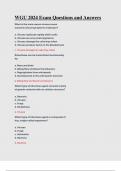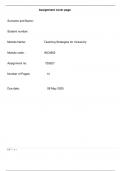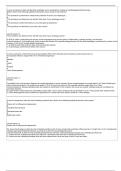Samenvatting Offender
Reintegration
CHAPTER 1: CONCEPTUALISATION
1. INTRODUCTION
− Many similar yet different ‘re-terms’
• Rehabilitation
• Resettlement
• Reintegration
• Recidivism
• Resocialisation
• Release
• Reentry
• …
− Wide variety of terms relating to something of reintegration/life after imprisonment
• They have something in common BUT also have nuances/different meaning from one another
− Narrow vs. broad perspective: outcome and process
• Rehabilitation = quitting the habit (more narrow)
• Reintegration = more broad
• Resocialisation = more focused on society
• Rehabilitation = more focused on personal aspects
− Reflected in the reader – importance for the group paper
Tertiary crime prevention “deals with actual offenders and involves an intervention in their lives in such a
way that they will not commit further offences” (Brantingham 1976)
Primary: prevent crime in community
Secondary: prevent in high risk groups (for
example: drug use)
Tertiary: preventing reoffending
1
, ➔ Focus on 3 main terms → By triple R model
➔ Classification of terms and definitions that we will use in this course
2. REHABILITATION → increase safety
− The forensic-psychological concept of rehabilitation is based on the
medical model encompassing assessment, management, and treatment
− It focuses on the individual and the risk of offenders; as such, it situates
the problem within the offender and the solution in the treatment room
− (Correctional) rehabilitation refers to (interventions aimed at) changing how offenders think, feel
or behave (eg, antisocial attitudes)
− Its aim of reducing recidivism is an individualised one: it focuses on intrinsic aspects of the
individual without considering or addressing the wider context
(eg, social and structural causes)
1) Risk-Need-Responsivity
− Focus on safety (recidivism)
− Risk-based
− Individual-centred
− Andrews and Bonta (1990)
− Still very relevant, widely used
2
,Risk (who we should treat)
= Treatment intensity should be matched to the risk level of offenders
− Only high risk individuals with intensive
treatment
→ Risk of offending or recidivism
→ More effective
People with high risk profiles who get intensive
treatment, have lower numbers of recidivism
But low profiles who get intensive treatment,
have higher numbers of recidivism
= For low risk offender we should include low intensity treatment
= For high risk we should use high intensity treatment
Need (what we should treat)
= Interventions should target dynamic risk factors (criminogenic needs)
8 key risk factors that we should focus on
• Variables that are causally related to offending
• They call them dynamic risk factors
(criminogenic needs)
• Dynamic because they can be changed
Criminal history is historical → the past
• We cannot change history
• Static
They are all related to the individual
• Wider life domains but relate to the person
having problems in these domains 3
, ! mental or physical health is not included in this model !
➔ High risk offenders will have more risk factors of these according to the model
Responsitivity (how we should treat)
= General: cognitive-behavioural and social learning interventions
= Specific: tailored to motivation, intelligence, gender, ethnicity, …
= very psychologically oriented
➔ Criminal behaviour is seen as a behaviour that can be unlearned
➔ With necessary interventions we can reduce criminal behaviours
4
Reintegration
CHAPTER 1: CONCEPTUALISATION
1. INTRODUCTION
− Many similar yet different ‘re-terms’
• Rehabilitation
• Resettlement
• Reintegration
• Recidivism
• Resocialisation
• Release
• Reentry
• …
− Wide variety of terms relating to something of reintegration/life after imprisonment
• They have something in common BUT also have nuances/different meaning from one another
− Narrow vs. broad perspective: outcome and process
• Rehabilitation = quitting the habit (more narrow)
• Reintegration = more broad
• Resocialisation = more focused on society
• Rehabilitation = more focused on personal aspects
− Reflected in the reader – importance for the group paper
Tertiary crime prevention “deals with actual offenders and involves an intervention in their lives in such a
way that they will not commit further offences” (Brantingham 1976)
Primary: prevent crime in community
Secondary: prevent in high risk groups (for
example: drug use)
Tertiary: preventing reoffending
1
, ➔ Focus on 3 main terms → By triple R model
➔ Classification of terms and definitions that we will use in this course
2. REHABILITATION → increase safety
− The forensic-psychological concept of rehabilitation is based on the
medical model encompassing assessment, management, and treatment
− It focuses on the individual and the risk of offenders; as such, it situates
the problem within the offender and the solution in the treatment room
− (Correctional) rehabilitation refers to (interventions aimed at) changing how offenders think, feel
or behave (eg, antisocial attitudes)
− Its aim of reducing recidivism is an individualised one: it focuses on intrinsic aspects of the
individual without considering or addressing the wider context
(eg, social and structural causes)
1) Risk-Need-Responsivity
− Focus on safety (recidivism)
− Risk-based
− Individual-centred
− Andrews and Bonta (1990)
− Still very relevant, widely used
2
,Risk (who we should treat)
= Treatment intensity should be matched to the risk level of offenders
− Only high risk individuals with intensive
treatment
→ Risk of offending or recidivism
→ More effective
People with high risk profiles who get intensive
treatment, have lower numbers of recidivism
But low profiles who get intensive treatment,
have higher numbers of recidivism
= For low risk offender we should include low intensity treatment
= For high risk we should use high intensity treatment
Need (what we should treat)
= Interventions should target dynamic risk factors (criminogenic needs)
8 key risk factors that we should focus on
• Variables that are causally related to offending
• They call them dynamic risk factors
(criminogenic needs)
• Dynamic because they can be changed
Criminal history is historical → the past
• We cannot change history
• Static
They are all related to the individual
• Wider life domains but relate to the person
having problems in these domains 3
, ! mental or physical health is not included in this model !
➔ High risk offenders will have more risk factors of these according to the model
Responsitivity (how we should treat)
= General: cognitive-behavioural and social learning interventions
= Specific: tailored to motivation, intelligence, gender, ethnicity, …
= very psychologically oriented
➔ Criminal behaviour is seen as a behaviour that can be unlearned
➔ With necessary interventions we can reduce criminal behaviours
4










